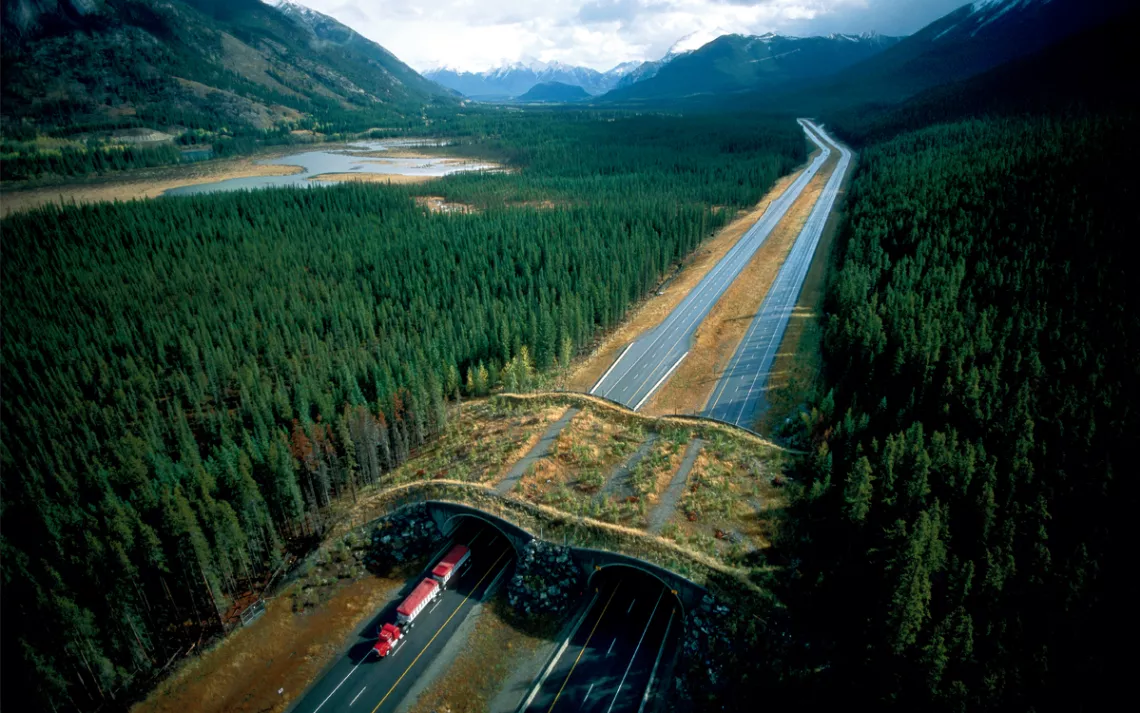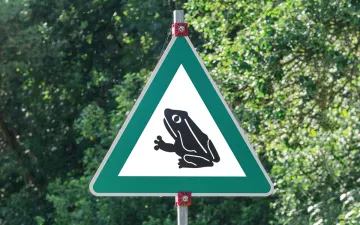Ending Roadkill: How to Make It Safer for the Deer to Cross the Road
Road ecologists are looking for a right-of-way for animals

Compared with other countries, the United States is a laggard when it comes to wildlife crossings. This bridge in Canada's Banff National Park was built in the late 1990s. | Photo by Joel Sartore
The Southern Rockies were shattered in the 1970s, when Interstate 70 drove an asphalt wedge through Colorado. The four-lane route, one of the longest veins in the country's then-new circulatory system of interstate highways, spurred human economies: Denverites drove west to ski each winter, and peaches and cherries flowed east in summer. As I-70 connected people, however, it divided wild animals. Traffic blocked wide-ranging creatures like elk, mule deer, and mountain lions from reaching their customary habitat and killed them when they tried to cross the pavement. Biologists eventually gave the interstate a dire nickname: the Berlin Wall for wildlife.
Like the original Berlin Wall, I-70 may prove an impermanent barrier. Since the early 2000s, conservationists have sought to retrofit the highway with structures that would permit animals to safely wander over and under its lanes. A half century after the interstate first cleaved the Rockies, that goal finally appears close to fulfillment. "Even a year and a half ago, wildlife crossings felt kind of like a pipe dream," Stefan Ekernas, the director of Colorado field conservation at the Denver Zoo, told me last summer. "Now there's not really a question anymore that it's going to happen."
One July morning, I joined Ekernas and his colleague Alex Wells to survey the ecosystem through which I-70 had punched. We drove to the crest of East Vail Pass, where the highway cuts through vast blocks of public land, and Wells pulled off to the shoulder. A stream of tractor trailers hurtled past; the triangular wedge of Pacific Peak towered above ski slopes still smudged with snow. We scrambled up an embankment into an airy copse of spruce and fir floored with marsh marigolds. "C'mon, where are you?" Wells muttered. After a few minutes of searching, we found what he sought: a motion-activated camera strapped to a post.
That wildlife crossings should someday come to I-70 is, in large measure, a testament to the power of cameras. Since 2015, researchers have set camera traps along I-70 to monitor the menagerie that dwells in the highway's vicinity. The project—a collaboration between the zoo, Rocky Mountain Wild, and Summit County Safe Passages—has revealed that East Vail Pass is a biodiversity hot spot. Among its highway-side fauna are moose, bighorn sheep, bobcats, martens, and, most elusive of all, lynx, perhaps 300 of which live in Colorado. In eight years of camera-trapping, scientists have documented five lynx, all on the interstate's south side—a powerful suggestion that I-70 is restricting the cats' range.
By 2020, the camera research had clearly demonstrated that East Vail Pass was a worthy candidate for wildlife crossings. That year, an engineering firm released a potential design featuring three passages: two capacious underpasses and an hourglass-shaped overpass, with miles of fencing between them to keep animals off the highway. Still, the crossings' prospects remained uncertain. Inflation and rising construction costs soon drove their forecast price tag from $21 million to $32 million—a pittance in the context of immense public transportation budgets but not chump change either. "It went from being a biology problem to a fundraising problem," Ekernas said.
A turning point arrived in November 2021, when the Bipartisan Infrastructure Law created a grant program earmarking $350 million for new wildlife crossings—the largest pot of money ever allocated to animal-friendly construction in the United States. The program requires states to contribute money as well, which spurred Colorado's legislature to pass a bill devoting $5 million to crossings the following year. The new state and federal funding sources mean that construction on the I-70 crossings could begin in the next few years. "Suddenly all these pieces are starting to gel," Ekernas said as we traipsed through the forest.
East Vail Pass is far from the only place where wildlife crossings are ascendant. Animal passages aren't a new concept: France began building "game bridges" over country roads for deer in the 1950s, and Germany, Switzerland, and other neighboring nations soon followed. American engineers built a few crossings in the 1960s and '70s for mule deer in Wyoming and Utah, but the United States has remained a laggard compared with Europe. Wildlife crossings gained traction in the US around 2000, as biologists demonstrated that passages and roadside fences could save the public money by preventing costly crashes with large animals like deer, elk, and moose. In Colorado, crossings have proved their worth on Highway 9, where two overpasses and five underpasses have slashed roadkill rates by more than 90 percent since 2015.
Crossings tend to take diverse forms, for the simple reason that different species have different passage requirements. Whereas predators like coyotes are content to slink through narrow underpasses, fleet-footed and farsighted creatures such as pronghorn prefer bridges with long sight lines that allow them to spot danger. "If you're a mountain lion, you need something very different than an elk," Wells pointed out.
This, then, is another valuable role for roadside cameras: Aside from showing where animals are crossing, they also alert biologists to which animals are crossing, and allow them to tailor crossings to local users. Until the I-70 camera traps captured evidence, for example, biologists didn't realize that bighorn sheep lived along East Vail Pass. "Now that we know there are bighorn sheep, we have to think about that," Ekernas said.
Even once the I-70 crossings are built (whenever that may be), the camera-trapping will continue for years. After all, you can't tell whether crossings are truly helping without before-and-after data. During my visit with Ekernas and Wells, we checked and set up cameras on both sides of I-70—strolling through aspen stands, picking our way along deer trails, clambering over deadfall as jumbled as pick-up sticks. Sometimes the highway disappeared behind screens of trees, but like the creatures living within its ambit, we never escaped its oceanic roar.
"You feel like you're absolutely out in the middle of nowhere," Wells said as we installed a new camera in a willow-lined valley—a sublimely peaceful spot, save for the whine of cars and trucks. "But then you have that constant reminder."
Despite the highway's racket, animals remained plentiful. When we checked the cameras' memory cards, we saw lots of elk, the occasional coyote, and a snowshoe hare, startled into a leap by some unseen predator. Mostly what we saw were mule deer—hundreds and hundreds of them, browsing shrubs and gazing placidly at the camera with big liquid eyes.
For all its ecological harms, I-70 doesn't actually inflict much roadkill: Its traffic is so constant that animals rarely attempt to cross it. But when they do, they often meet a fate as predictable as it is tragic. At day's end, we visited the body of a cow elk who had died as she braved the interstate's westbound lanes. She'd staggered off the asphalt to expire, and now her carcass lay sprawled in the grass: jaw shattered, guts and eyes devoured by scavengers, rib cage exposed to the sky. It was an ignominious end to a being who'd been so elegant in life. The wildlife crossings would come too late for her—but not, perhaps, for the rest of her highway-side herd.
Explore
Take a Sierra Club trip to Colorado. For details, see sc.org/outings.
More
In Montana, a booming population is restricting wildlife corridors: sc.org/mt-corridors.

For Every Critter, A Crossing
Colorado's lynx and elk are far from the only animals that need to navigate highways. Here are some other places where wildlife are getting an assist.
Big-Cat Bridge
In Southern California, cougars are so fragmented by freeways that some inbred populations face extinction. Fortunately, the Wallis Annenberg Wildlife Crossing, a 200-foot-long bridge over US 101 just west of Los Angeles, will allow the big cats to mingle and mate when it opens in 2025. Smaller animals, like bobcats, wrentits, and even lizards, should also benefit from North America's largest wildlife overpass.
Think of the Frogs
Amphibians are often crushed by cars as they migrate to breeding ponds on rainy nights, but strategically placed tunnels can help them complete their journey. In Monkton, Vermont, a pair of concrete-walled tunnels help more than 2,000 spotted salamanders, wood frogs, eastern newts, and other creatures cross under a busy roadway every spring.
How Did the Salmon Cross the Road?
It's not just mammals and amphibians that need help crossing highways—fish do too. Replacing small, dilapidated road culverts with bigger ones allows salmon and other fish to swim under roads unimpeded. The Bipartisan Infrastructure Law included $1 billion to retrofit and replace fish-blocking culverts, mostly in the Pacific Northwest.
 The Magazine of The Sierra Club
The Magazine of The Sierra Club



